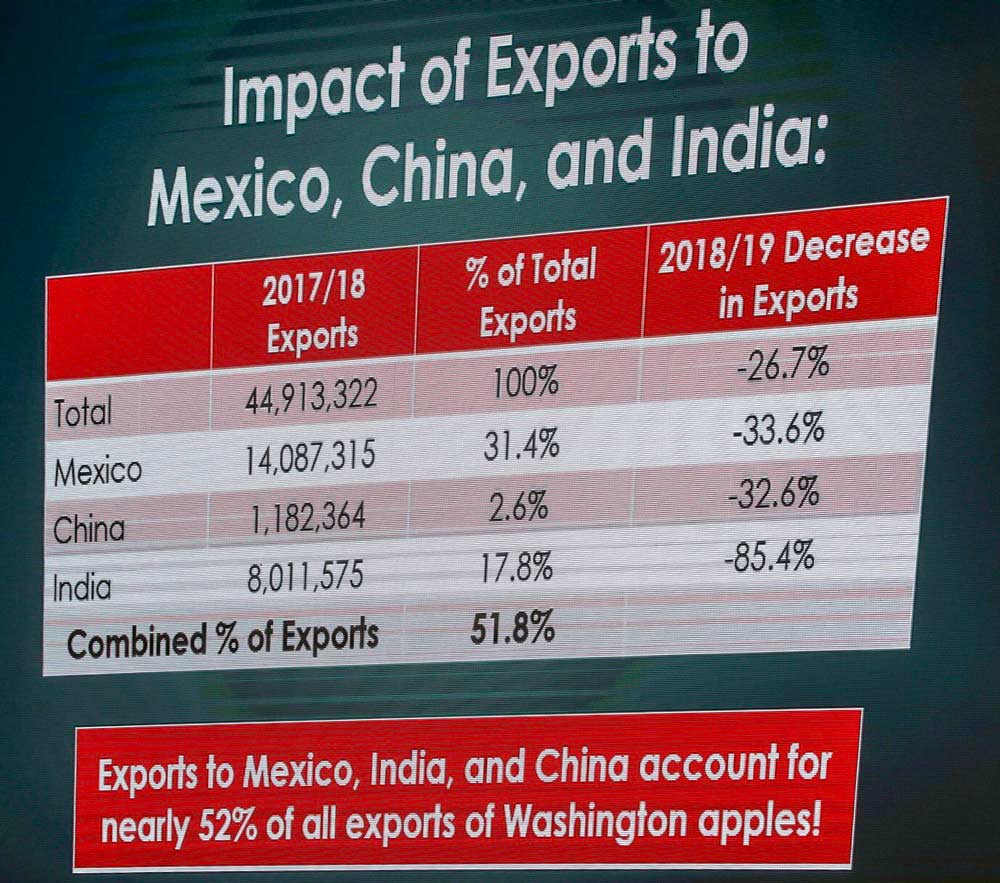
At the 2018 Washington State Tree Fruit Association annual meeting in Yakima, Washington, Washington Apple Commission president Todd Fryhover shared this graphic as he talked about decreased exports to Mexico, China and India due to ongoing trade disputes and retaliatory tarrifs. (TJ Mullinax/Good Fruit Grower)
In November, the U.S. Department of Agriculture committed to buying $15.5 million worth of apples for federal food distribution programs, which is only a fraction of the $93.4 million set aside for purchases intended to mitigate the effects of retaliatory tariffs either imposed or threatened by Mexico, China and India. The USDA has set aside $1.4 million for a similar program to buy fresh pears.
About half of the exported U.S. apples go to those three countries, said Mark Powers, president of the Northwest Horticultural Council, based in Yakima, Washington, which estimates the apple industry has lost $129 million due to the trade disputes. Pears have lost $2 million.
The contracts went to brokers across the country — companies from Texas, Florida and California joined those from Washington, Michigan and New York — but were designed to help make up for the profits potentially lost by producers who heavily rely on export markets made less accessible during President Donald Trump’s trade conflicts.
The USDA may make up to three more purchases during 2019, Powers said.
The industry should view the purchases as an “insurance policy,” Powers said.
The Horticultural Council, which represents the tree fruit industry in matters of national policy and foreign trade, began seeking help from the federal government in May, while in August the U.S. Department of Agriculture announced apples would be included in the overall $1.2 billion agriculture purchase.
Since then, growers in Washington, where the majority of fresh apples are grown, harvested fewer apples for the fresh market than they originally anticipated, making the situation less dire.
“If people don’t need it, great,” Powers said.
In early August, Washington growers anticipated a 131 million 40-pound box harvest but in October dropped that to 116.9 million boxes.
Also, the process to become a certified USDA vendor can be arduous, so many shippers from apple producing states chose not to apply, Powers said, adding that he knew of one Washington shipper who tried to create a new company to qualify but couldn’t finish by the deadline.
Every year, U.S. apple growers sell some fresh fruit to the federal government, which distributes to food banks, hospitals, college campuses and school lunch programs. But for this round, they changed the grade, size and variety specifications to include fruit that normally appeals to the international markets of Mexico, China and India.
Meanwhile, Powers and the Horticultural Council are lobbying the federal government to reach trade agreements with those three countries so that retaliatory tariffs are removed and also to open new international markets, such as Australia and South Korea, to apple and pear growers and improve phytosanitary access to Japan for all tree fruit, so the purchases become unnecessary.
“We want trade, not aid,” Powers said.
For a list of shippers and brokers participating in the USDA apple purchases, visit the following websites:
—http://nwhort.org/wp-content/uploads/2018/11/USDA-AMS-Bagged-Fresh-Apples-Announcement-110518.pdf
—http://nwhort.org/wp-content/uploads/2018/11/USDA-AMS-Fresh-Apples-in-Cartons-Announcement-110818.pdf
Related story: Tree fruit added to U.S. relief program for food impacted by trade disputes
–by Ross Courtney






Leave A Comment